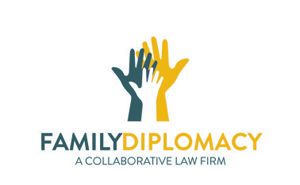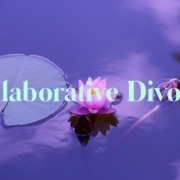Defining “Collaborative Mediation”
If you do a Google search for “Collaborative Mediation,” you will get all sorts of results, many of which have nothing to do with one another. Many articles simply point out the differences between Collaborative Divorce and Mediation (one of my blog posts would be included with this group).
Other articles will use the term to be a synonym with Collaborative Divorce, referring to neutral professionals (typically a financial professional and licensed mental health professional) as mediators, even if those professionals have not been trained as mediators. This seems misleading to me. Still, other articles use the term to mean a friendly mediation or an interdisciplinary co-mediation where lawyers are optional. I have concerns about those articles because, despite using the term “collaborative,” what they describe is not a Collaborative Law Process as defined by the Florida Statutes or Uniform Collaborative Law Act/Rules. Again, this is misleading.
 I recently was at the 12th Annual Conference of the Florida Academy of Collaborative Professionals (“FACP”) where I presented on the topic of “Collaborative Mediation: Engaging Mediators in the Collaborative Process.” My co-presenters were Heather McArthur, co-founder and president of Collaborative Professionals of Central Florida and Florida Supreme Court Certified Family Law Mediator, and Keith Grossman, a Florida Supreme Court Approved Primary Family Mediation Trainer and president of the Southwest Florida Collaborative Professionals Association.
I recently was at the 12th Annual Conference of the Florida Academy of Collaborative Professionals (“FACP”) where I presented on the topic of “Collaborative Mediation: Engaging Mediators in the Collaborative Process.” My co-presenters were Heather McArthur, co-founder and president of Collaborative Professionals of Central Florida and Florida Supreme Court Certified Family Law Mediator, and Keith Grossman, a Florida Supreme Court Approved Primary Family Mediation Trainer and president of the Southwest Florida Collaborative Professionals Association.
As I have not found a good definition anywhere else, one of my goals in co-presenting on this topic (and writing this article) was to define the term “Collaborative Mediation.” Additionally, I hoped to shed light on this distinct model of Collaborative Practice, find a way to better engage mediators in the Collaborative Process, and offer an option under certain circumstances that could bring more clients and lawyers into the Collaborative Method.
Definition of Collaborative Practice
When you get down to it, Collaborative Practice has three defining elements:
- Lawyers: Each client has a separate lawyer (for example, in a divorce, there is usually two lawyers, one for each spouse). This helps ensure that each client receives independent legal advice.
- Written Participation Agreement: The clients must sign a written participation agreement, outlining the rules and expectations for the Collaborative Process.
- Disqualification Clause: The participation agreement must include a disqualification clause that prevents the lawyers and any other professional involved from being used to fight in court. The professionals must also withdraw if someone terminates the Collaborative Process.
Studies from the Florida Academy of Collaborative Professionals and International Academy of Collaborative Professionals show that the Collaborative Process leads to a full resolution of all issues 85% and 86% of the time, respectively, and the Collaborative matters where I have been involved have fully resolved 92% of the time.
Definition of Mediation
When you get down to it, mediation has one main defining element:
- Mediator(s): There must be at least one neutral, independent mediator to help clients resolve disputes. The mediator does not have decision-making authority; rather, he or she utilizes skills to help the clients come to agreements.
Definition of Collaborative Mediation
Building upon the foundations of Collaborative Practice and mediation, Collaborative Mediation emerges as a distinct approach to conflict resolution. During our presentation at the FACP Conference, we proposed that Collaborative Mediation be defined by the following four elements:
- Lawyers: Each client has a separate lawyer.
- Written Participation Agreement: The clients must sign a written participation agreement.
- Disqualification Clause: The participation agreement must include a disqualification clause that prevents the lawyers, mediator(s), and any other professional involved from being used to fight in court. The professionals (including the mediator(s)) must also withdraw if someone terminates the Collaborative Process.
- Mediator(s): There must be at least one neutral, independent mediator.
Why the Distinction?
Mediation and Collaborative Practice have two distinct sets of rules. Mediation is governed by Chapter 44, Florida Statutes, as well as the Florida Rules for Certified and Court-Appointed Mediators. Mediation is also informed by the Mediator Ethics Advisory Committee Opinions of the Florida Dispute Resolution Center. Collaborative Practice, on the other hand, is governed by Part III, Chapter 61, Florida Statutes, Florida Family Law Rule of Procedure 12.745, and Rule Regulating the Florida Bar 4-1.19. Each profession is regulated by its own licensing entity. Collaborative Practice is also informed by the Minimum Ethical Standards of the International Academy of Collaborative Professionals and Florida Academy of Collaborative Professionals.
One area in which the two primary forms of dispute resolution diverge in Florida is in the confidentiality of material information learned during a caucus with a client. In traditional Collaborative Practice, transparency is required so that material information must be disclosed to both clients. In traditional mediation, confidentiality is required so that if a client asks the mediator not to disclose information while speaking separately with the mediator, the mediator cannot disclose that information.
Collaborative Mediation attempts to reconcile these two seemingly polar opposite approaches to material information. In a Collaborative Mediation process, the mediator cannot disclose information that the client says not to disclose, but he or she can help the client and attorney figure out an appropriate time, place, and manner for the other client to receive information needed to make an informed decision.
A Place for Mediators in the Collaborative Process
 In traditional Collaborative Practice in most communities, the only time that mediators are utilized is when the case is on the verge of breaking up. The mediator is brought in as a last-ditch effort to save the Collaborative matter by using a professional with a fresh perspective and different set of skills. This could still count as Collaborative Mediation so long as all of the defining elements above are met.
In traditional Collaborative Practice in most communities, the only time that mediators are utilized is when the case is on the verge of breaking up. The mediator is brought in as a last-ditch effort to save the Collaborative matter by using a professional with a fresh perspective and different set of skills. This could still count as Collaborative Mediation so long as all of the defining elements above are met.
In addition to the above scenario, Collaborative Mediation makes room for utilizing a mediator from the very beginning of a Collaborative Matter. The mediator may be the sole neutral professional, or he or she can work side-by-side with a Facilitator/Neutral Mental Health Professional, Neutral Financial Professional, and/or Child Specialist.
Different Roles for Attorneys in Collaborative Mediation
Further, attorneys can be used in different ways in Collaborative Mediation:
- They can appear at all Collaborative Mediation sessions between the mediator and the clients.
- They can serve as consulting lawyers to help clients prepare for meetings and review and draft any agreements reached, but not actually appear at any of the Collaborative Mediation sessions.
- They can appear at some, but not all, Collaborative Mediation sessions. For example, the lawyers may not be needed when parenting issues are discussed, but they may become vital when complex financial issues are addressed.
Mediators are Not Facilitators; Facilitators are not Mediators
Some mental health professionals have expressed concerns that they will be replaced by mediators in the Collaborative Process. I don’t believe that this would be the outcome of offering Collaborative Mediation as an option for dispute resolution to clients.
After all, mediators are not Facilitators.
In Florida, the term “Facilitator” is used synonymously with how the term “Coach” is used by the International Academy of Collaborative Professionals. Section 1.0 B 1 of the IACP Minimum Ethical Standards for Collaborative Professionals defines “Coach” as “a mental health professional whose function relates primarily to the emotional dynamics and communication between the client(s).” Facilitators are governed by their licensing board and chapters 490 or 491, Florida Statutes.
At the same time, Facilitators are not mediators. Mediator is defined by section 44.403(4), Florida Statutes,
as “a neutral, impartial third person who facilitates the mediation process. The mediator’s role is to reduce obstacles to communication, assist in identifying issues, explore alternatives, and otherwise facilitate voluntary agreements to resolve disputes, without prescribing what the resolution must be.”
Except for mental health professionals who are mediators, mediators do not have the training and background of Facilitators, and Facilitators do not have the training and background of mediators. So Collaborative Mediation is a completely different model of Collaborative Practice that might be geared towards a completely different clientele than the Neutral Facilitator/Neutral Mental Health Professional model of Collaborative Practice.
Further, I think that this model opens up opportunities for mental health professionals in Florida. In other jurisdictions, it is common to utilize a Child Specialist, defined by section 1.0 B 2 of the IACP Minimum Ethical Standards as “a mental health professional whose function relates primarily to the children or other dependent(s) of the client(s).” The Child Specialist brings the voice of the child into the room so the parents can consider the children’s explicitly expressed interests when making decisions. Because the main neutral in Collaborative Mediation may be a mediator rather than a Facilitator, we may not get the refrain from parents, “Why do we need a second mental health professional?” The Child Specialist may be the only mental health professional on a Collaborative Mediation team, and so clients may find this role more valuable.
Why Clients Might Choose Collaborative Mediation
Clients generally choose Collaborative Practice over mediation because they might need more support than mediation can offer. So why might they choose Collaborative Mediation rather than the Neutral Facilitator/Neutral Mental Health Professional model of Collaborative Practice? Here are a few reason:
- The Matter Originates from the Mediator. Mediators are an untapped market for the creation of Collaborative matters. Sometimes it is clear that the clients need lawyers from the beginning of a mediation, but sometimes everyone realizes this later on. Either way, the mediator would benefit from referring the clients to Collaborative lawyers and converting it into a Collaborative Mediation as they know that everyone is working towards resolution; Collaborative Lawyers are disincentivized from taking the case out of the Collaborative Mediation process and into litigation because they would be fired.
- Clients and Lawyers are more Familiar with Mediation. Most clients have heard of mediation but not Collaborative Practice, and so it may be easier to get them to sign up for a Collaborative Process that involves mediators. Similarly, almost all family law attorneys are familiar with mediation, but even lawyers who have gone through a Collaborative training may not fully understand the Collaborative Process or how to explain it. Accordingly, Collaborative Mediation may offer a pathway for these lawyers to get a taste of the Collaborative Process which might bring them to a local Collaborative Practice group, allowing them to become more educated and enmeshed within the Collaborative community.
- Fear of Mental Health Professionals. Even though in Florida we tend to use the term “Facilitator” instead of “Neutral Mental Health Professional,” sometimes nomenclature does not matter. There are clients who have a fear of mental health professionals or who just refuse to work with them. It might be a cultural bias or it may be due to a trauma. Either way, in most Collaborative matters it is beneficial to have a neutral. Especially if it is not a numbers-heavy case, a mediator may best fit the bill.
- Confidentiality Rules of Mediation versus Collaborative Practice. I already addressed the difference between caucusing in Collaborative Practice as compared to mediation, and clients might have a preference of one over the other. But there is also the issue that mediation confidentiality has held up in court time after time, while the confidentiality and privilege under Florida’s Collaborative Law Process Act is relatively new and has not yet been tested. Now, I have full confidence that Collaborative confidentiality would be supported by the courts just as strongly as mediation confidentiality. However, a client may have a particular privacy concerns and want mediation confidentiality to apply to their Collaborative Process.
- Cost of One Neutral Instead of Two. One of the biggest challenges that professionals face when explaining the Collaborative Process is the discussion of multiple neutral professionals and associated costs. I strongly believe that the efficiency and value of the Facilitator and Financial Professional outweigh cost concerns in most cases, but there are times when the clients just will not agree to multiple neutrals. In these instances, they may prefer a mediator to serve as their neutral because of perceived cost-savings. Keep in mind, there can be more than one neutral in a Collaborative Mediation, including additional co-mediators, a Facilitator, a Financial Neutral, and/or a Child Specialist.
Conclusion: Embracing Collaborative Mediation
Again, my main goal for the FACP presentation was to define the term “Collaborative Mediation,” as I saw it being used in ways that I thought was misleading. With the presentation and this article, I think I have accomplished this. Additionally, I hoped to shed light on this distinct form of Collaborative Practice, find a way to better engage mediators in the Collaborative Process, and offer a model that could be used under certain circumstances to bring more clients and lawyers to the Collaborative Method.
If you are a professional or potential client who has questions about Collaborative Mediation, I invite you to contact me.
Adam B. Cordover is a thought-leader in the international Collaborative community and a Florida Supreme Court Certified Family Law Mediator. Adam is co-author of an American Bar Association book on Collaborative Practice and has travelled throughout the U.S., Canada, Israel, and France to lead trainings and workshops on alternative dispute resolution for professionals. He is a member of the Board of the International Academy of Collaborative Professionals and recipient of the inaugural Visionary Award of the Florida Academy of Collaborative Professionals for creating and co-instructing the first FACP Leadership Institute. Adam represents clients virtually throughout the State of Florida, and he has offices by appointment in Tampa, Saint Petersburg, and Sarasota.







